
BY BILL ADAMS
The Weis family and fire equipment sales under various monikers have been a Salina, Kansas, mainstay for almost 60 years. In the early 1960s, Gary L. Weis felt there was a need for a quality extinguisher service and sales outlet in the Salina area.
He had previous experience in the fire extinguisher business, so in 1963, he started a business called American Fire Equipment. In the mid 1980s, he changed the name to Weis American Fire. In 1974, son Mike started working part-time for the family business during the summers. Wanting to retire, Gary sold the business in 1990. Mike stayed active in the fire equipment business with another company.
Fire equipment and fire trucks are in the Weis bloodline, so in 1995, the business was restarted under the name of Weis Fire and Safety Equipment. Gary became the CEO. Gary’s wife Char took on the role of CFO and was in charge of marketing. Mike became the president. The family worked tirelessly to re-fire the company at a different location, just a few blocks from the original business in Salina. Mike says, “It was basically starting from scratch, but we had a lot of experience and a great name.”
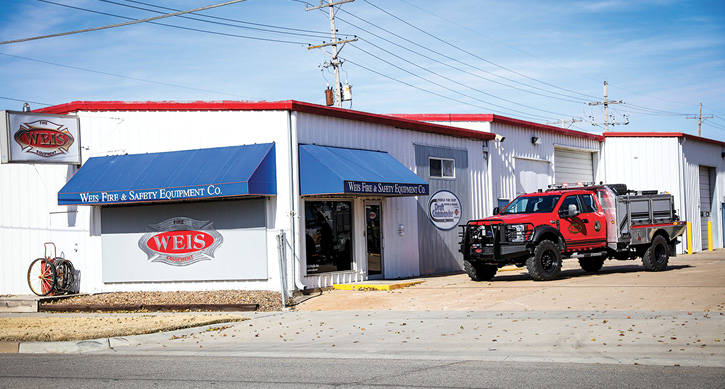
1 The original Weis Fire and Safety building on the left was purchased in 1995. Several additions were made, and additional buildings were purchased. The facility now includes more than 25,000 square feet. (Photos courtesy of Weis Fire and Safety unless otherwise noted.)

2 This two-door extended cab Ford F-550 is a typical Weis Quick Attack. It features a “whip line” that can be operated by a seated and belted passenger in the cab. Most have a ground sweep nozzle on each front bumper corner and a bumper-mounted cab-controlled Task Force Tips Tornado 15- to 120-gpm monitor. The Weis-designed bumper is provided on most of its brush trucks. Tanks are usually 300 to 400 gallons with pumps that are self-contained and rear-mounted with their own engines. When provided, spare tires are usually mounted on top of the tank. This rig has an LED scene light on each side.
An opportunity arose in the summer of 2019 allowing Gary and Char to retire and for Mike to partner with B12 Capital Partners to bring in some new investors and recapitalize the company. Today, the company is a privately held LLC. Mike Weis is still president. Mike Wedel is chairman and David Hansen is the CEO. The company logo, prominent on its literature and building, is a Maltese cross with “Weis” in the middle, “Fire” on top, and “Equipment” on the bottom. The company’s e-mail address is [email protected]. Regardless if it is called Weis American, Weis Fire Equipment, Weis Fire & Safety, Weis Fire & Safety Equipment, or simply Weis Fire, the company continues to be a strong and growing presence in the fire service.
FACILITY
The current location began as a 3,200-square-foot building in 1995 (photo 1). Additions were made, and more buildings were acquired over the years. The Weis facility currently encompasses some 25,000 square feet in multiple structures taking up most of a city block. In addition to manufacturing, sales, office, and warehouse areas, three bays are devoted strictly to service. There are 30 employees.
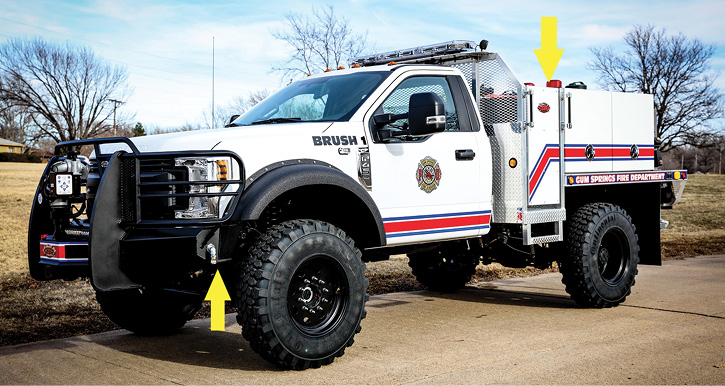
3 A two-door Ford F-450 was delivered to Gun Springs Fire & Rescue in Arkansas. It has a 20-inch-wide walkway between the cab and the 300-gallon tank, an onboard foam system, a monitor, and corner ground sweep nozzles on the Weis bumper.

4 Four identical Quick Attacks on Ford F-450 Quad Cabs for the Pottawatomie County District 1 in Kansas are lined up in front of the Weis “wildland” fabrication shop. These rigs have 300-gallon tanks, onboard foam, and midbody ground sweep nozzles in addition to the two on the front bumper.
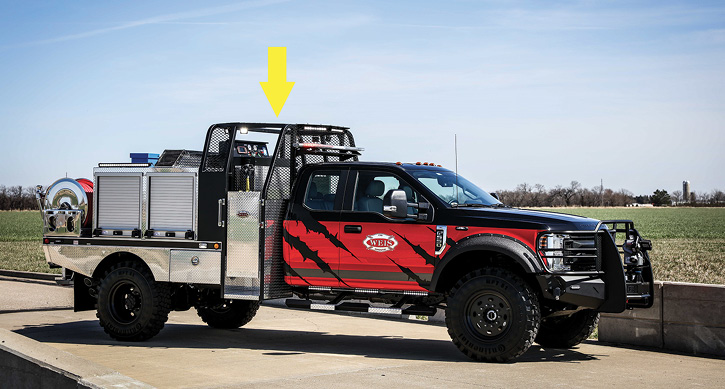
5 A Weis Fire demonstrator Quick Attack on a Ford F-550 Quad Cab features an NFPA 1906-compliant rollover structure that meets the side impact and crush criteria in SAE J1194 for Wheeled Agricultural Tractors. It’s called the Weis Rollover Protection System (WROPS).
FIRE APPARATUS
During the 1960s and 1970s, Weis sold more than 600 apparatus for the former American Fire Apparatus of Battle Creek, Michigan. Started in 1937, American Fire Apparatus featured the Barton fire pump, which originated in 1922. Also known as Barton-American, the apparatus were very popular with small-town fire departments. In 1937, American Fire Apparatus opened a second plant in Marshalltown, Iowa, about 400 miles from Salina. It eventually ceased operations in 1994.
Gary Weis started building rural fire apparatus under his own name back in the 1960s on surplus military trucks to address the very rural areas in Kansas that were subject to grass and field fires. Today, those same grass and field fires have been given the politically correct and semiformal descriptions of wildland fires, vegetation fires, and wildland urban interface (WUI) hazards. Regardless of what they are called, the Weis apparatus are designed to attack them—off road and cross lots.
When Gary came out of retirement in 1995, the Weis clan continued building their own apparatus, bringing them to another level with the availability of the Ford F-550 chassis in 2002. Mike Weis says, “My father admits what we are building today is far more structurally and technically advanced than the trucks of old. He still enjoys telling people and friends about the products we manufacture.”
Weis is also the authorized distributor in Kansas for Toyne Fire Apparatus of Breda, Iowa. The Toyne and Weis lines complement each other. Toyne apparatus are manufactured to comply with National Fire Protection Association (NFPA) 1901, Standard for Automotive Fire Apparatus, whereas the Weis fire apparatus are manufactured in-house to be specifically compliant with NFPA 1906, Standard for Wildland FireApparatus.
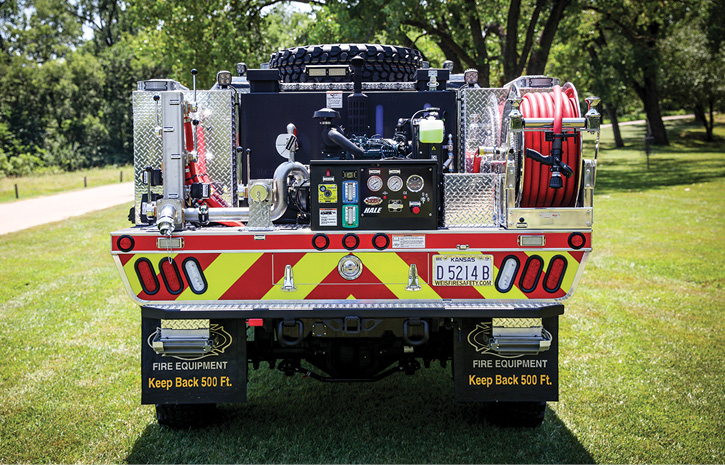
6 The working end of a Quick Attack brush truck showing the typical locations for the booster reel, pump and controls, and hose connections.
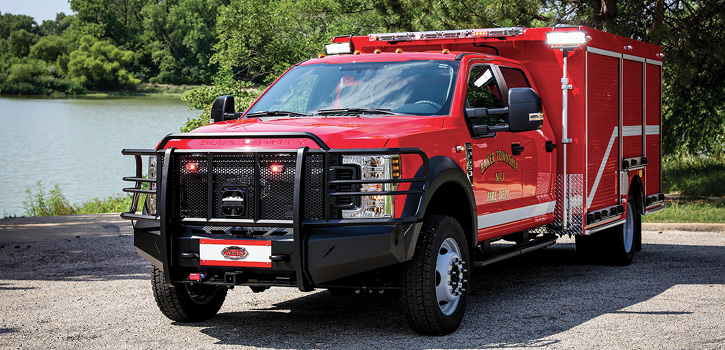
7 Baker Township Fire Department No. 1 in Crawford County, Kansas, took delivery of this light walk-around rescue built by Weis on a Ford F-550 four-door chassis. The 144-inch-long body is fabricated of 3⁄16-inch aluminum plate.

8 An inside view of the “wildland” fabrication shop showing the four rigs in photo 4 under construction.
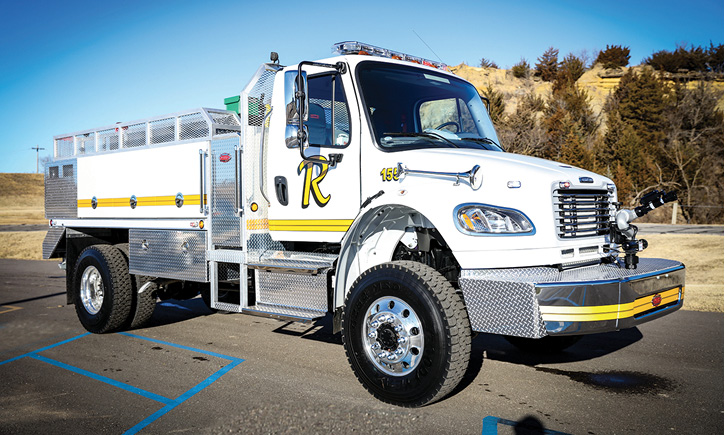
9 Ray, North Dakota, took delivery of this 1,000-gallon Stallion tanker on a two-door Freightliner chassis. It has an extended bumper with a monitor and interestingly no ground sweep nozzles.
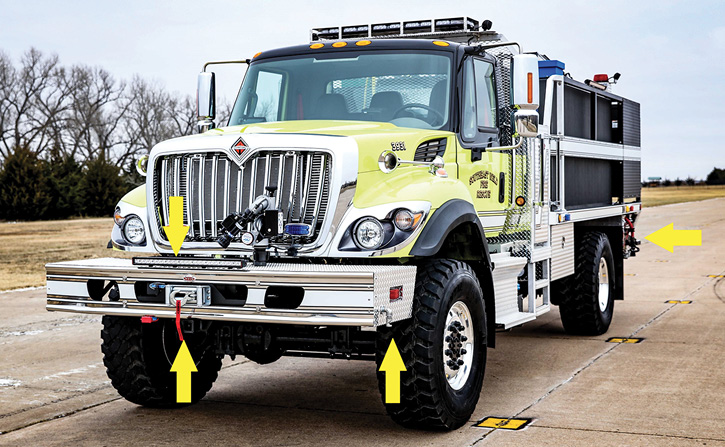
10 The Southeast Weld County Fire Rescue in Keenesburg, Colorado, has this 1,800-gallon Stallion tanker on a two-door International chassis. It has a 24-inch extended front bumper with winch, receiver, monitor, and two ground sweep nozzles. The controls for the rig’s pump are located in the walkway behind the cab. The booster reel is “hung” beneath the body behind the rear wheels on the driver’s side. Note the low mounted scene light on the front bumper extension.

11 Stanley, North Dakota, runs this 1,000-gallon Stallion tanker on a four-door crew cab International chassis. It has mid-body ground sweep nozzles and an extended front bumper with two additional ground sweep nozzles.
QUICK ATTACKS AND STALLIONS
The Weis-built Quick Attack series units meet the requirements of NFPA 1906 Chapter 5, Wildland Suppression Apparatus. They are commonly referred to as grass fire trucks, brush trucks, and field fire trucks. Common configurations for Quick Attacks include a 300- to 400-gallon booster tank and a rear-mounted self-contained pump with integral engine that I generically define as operating at “high pressures and low volumes” as well as at “low volumes and high pressures.” Hale and Darley pumps are featured in the online delivery photographs on the Weis Web site. Both manufacturers feature full lines of pumps with various flows and pressures for “wildland” use. Basic pump controls are duplicated intra-cab including start/stop and controls for ground sweep nozzles and a front bumper monitor if so equipped (photos 2 and 6).
Most are equipped with Weis three-inch high-lift kits with single 41-inch extra-large tires and a Weis-designed front bumper (photos 2, 3, 4, and 5). When asked about the functionality of his Quick Attacks, Mike Weis says, “Most of the Quick Attack trucks we build have become very popular on nonstructural calls where a 40,000-pound rig is not necessary or feasible. Quick Attacks and the light rescues, which we also manufacture in-house, are easier to drive, cost less to maintain, and are more maneuverable.”
The Weis line of Stallion tankers is manufactured in compliance with NFPA 1906 Chapter 7, Wildland Mobile Water Supply Apparatus. It is important to point out the wildland mobile water supply apparatus are not intended to be NFPA 1901-compliant “water haulers” or tenders. However, Weis has delivered Stallions with dump valves and hydraulic racks for portable tanks. Kennedy, Texas, has a 1,200-gallon tanker with a side dump and hydraulic tank rack. Lewis, Kansas, runs with a 3,800-gallon tanker with a swiveling rear dump and a hydraulic tank rack.
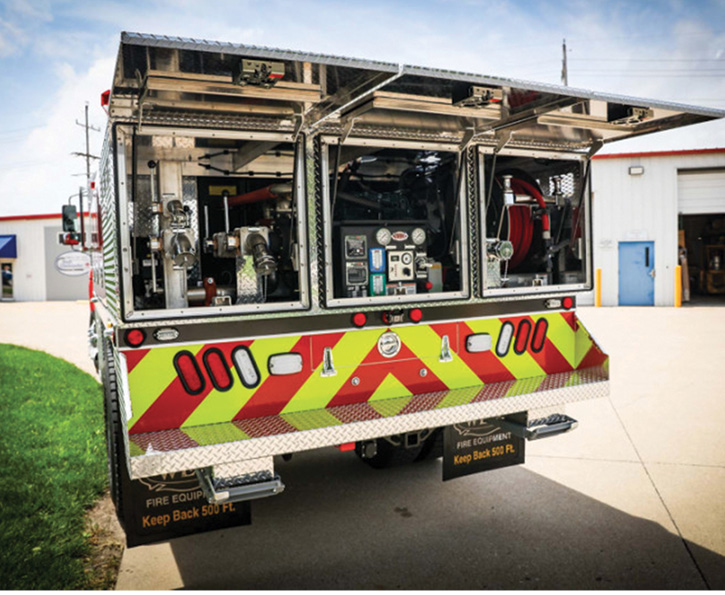
12 A rear view of the Stanley tanker shows the pump, hose connections, controls, and booster reel protected behind three lift-up doors.
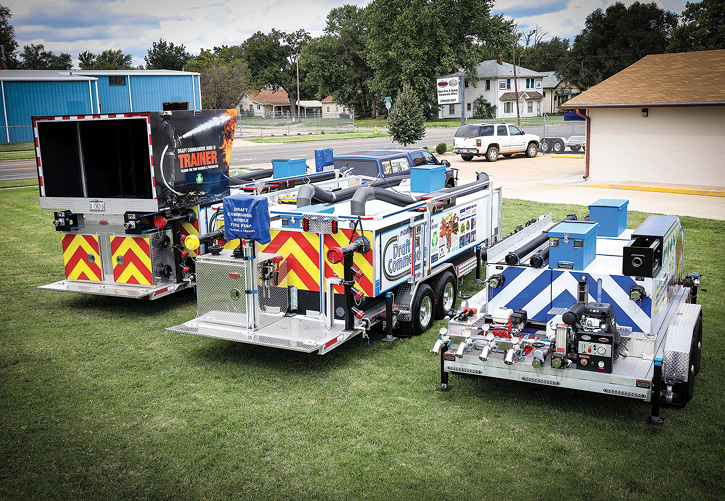
13 This photo shows the Draft Commander family of three units designed by Weis Fire and Safety to test fire pumps and fire appliances and train firefighters and fire pump engineers. Left to right are the Draft Commander 3000® Trainer, Draft Commander 3000®, and Draft Commander Mobile Appliance Tester.

14 The Draft Commander 3000® Trainer is a training innovation in allowing firefighters to recycle (conserve) discharge water directly into the Training Receiver.
Mike Weis says, “Our Stallions are Quick Attacks on steroids.” As an example, the Stallion tanker delivered to Stanley, North Dakota (photo 11), features a 33,000-pound gross vehicle weight rating (GVWR) four-door International 6×4 chassis with a 1,000-gallon booster tank, a self-contained Darley pump with ratings of 65 gallons per minute (gpm) at 250 pounds per square inch (psi), 130 gpm at 200 psi, 200 gpm at 150 psi, and 280 gpm at 100 psi. In addition to the rear pump controls, inside the cab on the console are secondary pump start/stop controls, a pressure gauge, and a tank level indicator. There are four ground sweep nozzles, one on each side at the front corners of the bumper and one on each side at the front corners of the body. They are controlled on the cab console—one switch for the left side and one for the right side. Class A foam is piped to all the pump’s discharges. The rig is designed to go off road and tackle vegetation fires on the move.
Asked if purchasers tend to customize the Stallions, Mike Weis replies, “We have seen a real uptick on these ‘BIG BRUSH TRUCKS’ lately.” NFPA 1906-compliant apparatus are specifically designed and engineered for off-road use and have stability and clearance criteria much more stringent than NFPA 1901 apparatus. Over the years, we have provided hundreds of wildland fire apparatus across the country.”
WROPS
At FDIC International 2016, Weis introduced the Weis Rollover Protection System (WROPS) (photo 5). It was designed to comply with NFPA 1906 and the Society of Automotive Engineers (SAE) J1194 standard. It may have been the first manufacturer in the industry to do so. NFPA 1906 basically says if a noncab firefighting position is provided, it must meet certain criteria including seating, control locations, communication with the driver, and signage. NFPA 1906 sentence 14.4.3.2 states: “A protective structure shall be provided in compliance with the side impact and crush criteria from SAE J1194, Rollover Protective Structures (ROPS) for Wheeled Agricultural Tractors.” The WROPS does.
Mike Weis reiterates, “In order to use this stand-up position, the apparatus must have a rollover protection system that meets SAE J1194 and has been third-party certified. AND YOU MUST BE SEATED AND BELTED WHILE THE TRUCK IS IN MOTION in order to be an NFPA 1906 compliant system.
“We do build apparatus with a riding position by providing an NFPA-compliant rollover system that meets SAE J1194 standards. What sets ours apart from others is that we have two fold-up seats with compliant seat belts, one on each side. NFPA says the rider must be seated and belted when the truck is in motion and fighting fire.
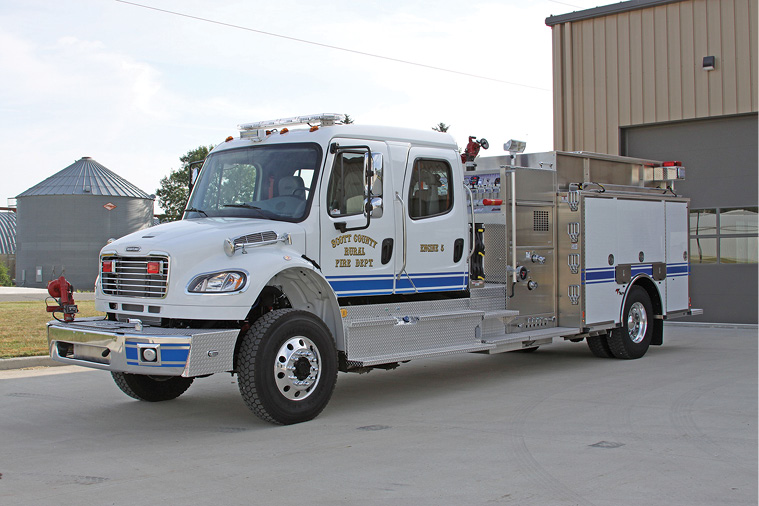
15 Weis Fire and Safety delivered this Toyne 1,250-gpm 1,250-gallon pumper-tanker to the Scott City (KS) Rural Fire Department on a four-door Freightliner. It features high left- and low right-side compartments, top-mount pump controls, a booster reel in the rear step compartment, an 8-kW hydraulic generator, and an extended front bumper with a monitor and a discharge for a preconnect. (Photo courtesy of Toyne.)
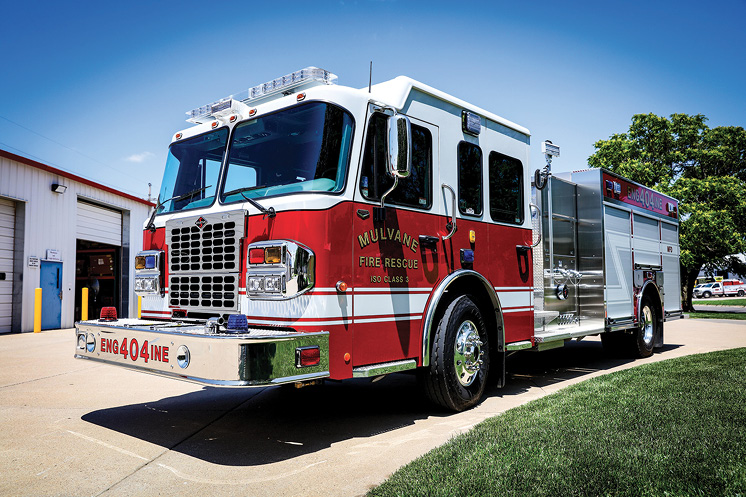
16 Weis delivered this Toyne tanker to Shawnee Heights in Tecumseh, Kansas. It has a 1,500-gpm pump and a 3,000-gallon tank mounted on a Kenworth two-door tandem chassis. A unique feature is the location of the side tank dump valves on each side immediately aft of the pump house. There’s a right-side powered rack for a portable tank, a rear dump valve, and rear slide-in ladder storage.

17 Another Kansas Toyne delivery by Weis went to Mulvane Fire Rescue. It has a top-mount 1,500-gpm pump and a 1,000-gallon tank on a Spartan chassis with double high side compartments and slide-in ladder storage at the rear.

18 Humboldt, Kansas, took delivery from Weis of this 1,250-gpm pumper with a 1,250-gallon tank on a two-door International chassis. It has double high side compartments, and rear slide-in ladder storage and the booster reel is mounted in the upper portion of the rear step compartment.
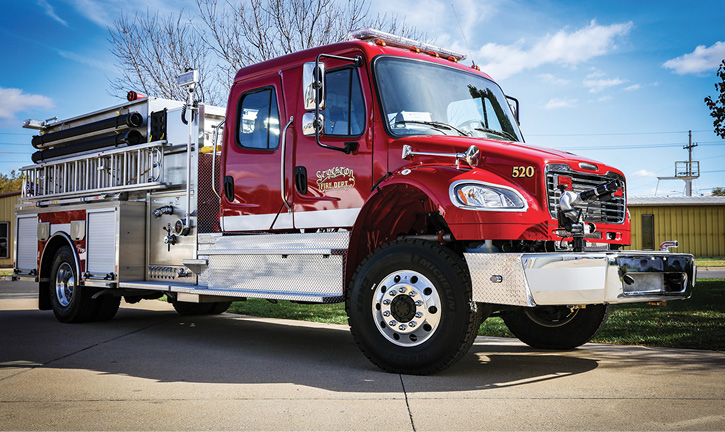
19 Weis delivered this Toyne on a four-door Freightliner to the City of Stockton, Kansas. It has high left- and low right-side compartments, slide-in ladder storage at the rear, an extended front bumper with a monitor, a floor-mounted booster reel in the rear compartment, a 1,250-gpm pump, and a 1,250-gallon tank.

20 A Weis delivery to Blue Township, Pottawatomi County, Kansas Fire District 5 of a Toyne side-mount pumper on a Spartan Metro Star chassis. It has a 1,500-gpm, 1,000-gallon tank, double high side compartments, and slide-in ladder storage in the rear. (Photo courtesy of Toyne.)
“One of the challenges when we designed this system three years ago was that we know the occupant is going to want to stand up. It is hard to design a system to comply to a standard when we know that some departments ‘might’ have no intention of employing the system as it was designed. The real question is what happens when NFPA 1500 [Standard on Fire Department Occupational Safety, Health, and Wellness Program] collides with NFPA 1906, which allows for a riding position outside of the cab when certain requirements are met. NFPA 1500 does not recognize any riding position outside of the cab. We are, however, seeing a trend in reduction of orders with riding positions. Today, we can provide all the pump controls from inside the cab with remote control front bumper nozzles and ground sweep front bumper spray nozzles all being controlled from inside the cab.”
Noncab firefighting positions meeting NFPA 1906 criteria are only allowed on apparatus with no more than a 19,500-pound GVWR. NFPA 1906 Chapter 14, Driving and Crew Areas, Section 14.4* On-Board Pump-and-Roll Fire-Fighting Positions, Sentence 14.4.1 states: “If an on-board pump-and-roll firefighting position as described in this section is provided, it shall be on a wildland fire apparatus with a GVWR of no more than 19,500 pounds.” I don’t know why.
THE DRAFT COMMANDER SERIES
Gary Weis invented the Draft Commander Mobile Fire Pump Testing and Training unit. He developed the first unit in 2002 and field tested it for five years, performing more than 1,000 fire pump tests. According to Mike Weis, “In 2007, we recognized a need in the fire service. We built a unit that a company in Texas bought and displayed at a trade show in Atlanta in 2007. It was a big hit. The customer loved it. We refined the unit and built another one and took it to the Fire Department Instructors Conference in March 2008. The following Monday after the show, a company from Florida bought it. Since then, we have delivered hundreds across the nation and around the world to municipal fire departments, military installations, the nuclear industry, and companies providing annual fire pump testing for fire agencies.”
The Draft Commander 3000® was awarded a United States Patent in 2010. According to Mike Weis, there are almost 300 units in service worldwide and they have added to its family of products. He notes, “There is a 4,000-gallon unit available that was designed primarily for the industrial users and the nuclear industry, due to their larger capacity pumps. The 3,000-gallon units will do everything most people want and is by far the most popular.”
In 2018, the first Draft Commander 3000® Trainer was created, which could recycle discharged water from training exercises. In 2019, the Draft Commander 3000® Trainer was awarded a United States Patent. One of the company’s brochures states the units recycle clean water and “drafting test pits have become obsolete.” Mike Weis says, “The Trainer was really designed out of a problem that a lot of customers were having: water conservation. That and environmental concerns have really become important issues. The Trainer solves that problem.”
The most recent addition is the Draft Commander Mobile Appliance Tester that facilitates testing handline fire nozzles up to 500 gpm, fire hose couplings, fire hose, hard suction hose, and fire appliances—all in accordance with NFPA 1962, Standard for the Care, Use, Inspection, Service Testing, and Replacement of Fire Hose, Couplings, Nozzles, and Fire Hose Appliances. It serves the dual function of testing appliances and training fire pump engineers and firefighters.
TOYNE
Mike Watts, Toyne’s national sales manager, says, “Weis Fire and Safety has been affiliated with Toyne for several years. Mike and his crew do a great job promoting the Toyne product line and taking care of the end user. This striving for excellence and their great performance led them to the position of dealer of the year within the Toyne family of dealers during this past sales year. We at Toyne look forward to continuing success with Weis Fire and Safety as we move into the future.” In addition to receiving the Dealer of the Year award at the 2019 Toyne Dealer Summit, Weis Fire and Safety was awarded both the Outstanding Achievement and Outstanding Sales Performance awards.
INTERVIEW WITH MIKE WEIS
Mike Weis was asked to comment on the apparatus purchasing trends in his marketing area. He notes his comments are only particular to the rigs Weis manufactures and the Toyne apparatus Weis has sold.
What was the most common Toyne rig sold?
“The orders this year were a combination of custom and commercial pumpers and tanker/tenders. This year was more commercial than custom chassis.”
Is there a preferred pump size for pumpers?
“I have been in this business long enough to remember when 500 gpm was the norm, but today the trend is 1,250 gpm to 1,500 gpm.”
Is there a preferred booster tank size for pumpers?
“Most of our rural customers (the bulk of our orders) are 1,000- to 1,250-gallon capacity.”
Is there a popular pumper cab seating capacity?
“Five is prevalent for volunteers and four to six for career departments.”
Is there a trend toward the “Clean Cab Concept?”
“Yes. I am talking about it whenever I am sitting down with a committee. Weis Fire is a member of [the Fire Apparatus Manufacturers’ Association] FAMA, and that has been a big topic. All of the departments I have spoken with are somewhat or very familiar with the reason and the need, but a lot of them don’t have the budget for that. But, I am encouraged about the customer awareness, and some are already moving or preparing for the future.”
What are the most popular apparatus color schemes?
“Black or gray over red.”
Is there a trend toward onboard foam systems?
“Most apparatus we sell or manufacture have some form of a Class A foam delivery system.”
Is there a preference for relief valves or pressure governors?
“Pressure governors all the way; they are easier to use, more reliable, and accurate.”
Do most fire departments make bidders follow the department’s purchasing specifications or do they just take low bid regardless of compliance?
“Most of our customers stick to their specs. The specs they write are directly related to the quality of the truck they want.”
What are your thoughts on cooperative purchasing?
“Done correctly, cooperative purchasing, such as the Houston Galveston Area Council (HGAC) cooperative purchasing program, can save the customer time and money. It has for ours. We are on HGAC, and our customers love it. The advantage to the customer is they can get the truck they want from whom they want and still negotiate a fair price.”
What’s the preferred Toyne body construction in Kansas?
“Toyne has gone to all stainless, with the majority of apparatus being the bolted/brushed.”
Do you see open, generic, performance or proprietary purchasing specifications when customers spec NFPA 1901-compliant apparatus?
“All of the above. It doesn’t take long to figure out what the intentions of the customer are. If the spec is written specifically around one manufacturer, I usually don’t bid. I believe that a customer should be able to purchase the apparatus that they want, from whom they want, and what is in the their best interest, and if I can see that in their specs, I don’t see the need to get in their way.”
Do you see open, generic, performance, or proprietary purchasing specifications when customers spec NFPA 1906-compliant apparatus?
“Most of our customers recognize and appreciate the quality and attention to detail we provide. We see them writing that into the specs when they do go out to bid. A lot purchase from the HGAC.”
Any observations or comments on apparatus purchasing trends in Kansas?
“One of the things that I have seen recently is that more and more customers are buying the apparatus fully loaded with all new equipment, radio, turnkey. It just makes more sense.”
Do you want to comment on apparatus OEM mergers in the industry?
“It really doesn’t matter to me, but it does make for a lot of gossip!”
Do you have any comments on current or proposed NFPA 1901 criteria?
“Something really does need to be done to dim LEDs at night. I’m glad it is being discussed.”
Is there a trend toward onboard foam systems on Quick Attacks and Stallions?
“Almost 100 percent have foam.”
Do many customers customize their Quick Attacks?
“Yes. We are not a cookie-cutter builder. We really do sit down with potential customers to figure out what THEY want, not what I want.”
What are the most popular options on Quick Attacks?
“400-gallon tanks, front bumper and front bumper spray nozzles, backup cameras, foam, extra storage, thermal imaging systems, lift kits, and big tires. Customers like smaller, lightweight, midrange pumps, and we like to match the pump engine to the fuel used for the chassis.”
Weis also adds, “We provide products, services, and solutions to the greatest people in the world—our first responders. It takes a great team to do that, and over the years we feel we have built the greatest team in the industry.”
BILL ADAMS is a member of the Fire Apparatus & Emergency Equipment Editorial Advisory Board, a former fire apparatus salesman, and a past chief of the East Rochester (NY) Fire Department. He has 50 years of experience in the volunteer fire service.

